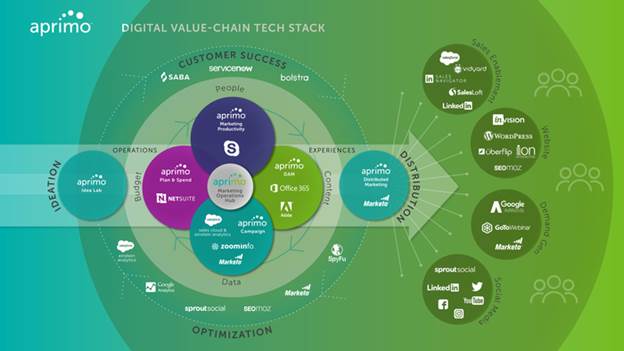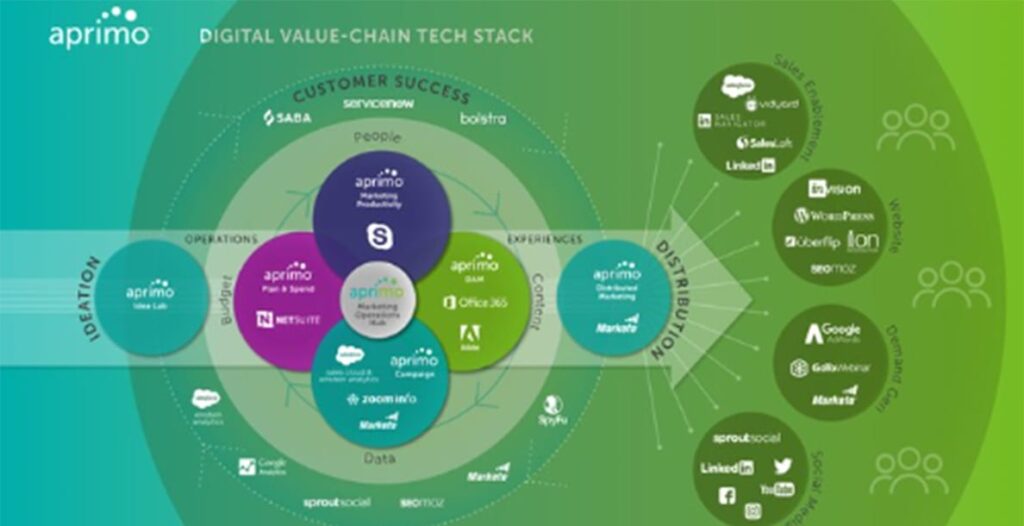A Tech Stack?a comprehensive list or representation of all the systems your organizations uses across its enterprise?can offer a multitude of benefits that go well beyond the IT department.
Companies can create Tech Stacks by engaging coordination with stakeholders in IT, HR, marketing, and other departments to identify and create a list or visual representation of each system they use, how they connect together, and how they are used across the enterprise.
But marketing organizations specifically can derive value by using Tech Stacks to help visualize, communicate, understand, and plan improvements to their organization’s technology infrastructure to help create more targeted campaigns and enhanced customer experiences.In our last blog, we discussed how to go about assembling your tech stack. Now in this blog, we want to present how Aprimo developed our own tech stack (shown below) and how we use it to enhance our marketing operations.
 Developing a theme
Developing a theme
We found that having an over-arching theme for our tech stack and a detailed visualization of how we wanted to use it to get products to market helped us better design it.
Tech Stacks based on an overarching theme, such as the buyer’s journey or the different phases of product creation and delivery, can help marketing leaders better envision how the compilation of such systems is essential to successfully executing various campaigns.
For example, we named our tech stack the Digital Value-Chain Tech Stack to keep us grounded in our goals of improving digital experiences for our customers and prospects. We then looked at the full cycle of how we execute marketing activities from ideation to creation to distribution and curated our tech stack around those three areas.
Then we began to look at technologies that would provide digital value across this marketing workflow as well as how we could optimize them to improve customer success in the meantime.
Assessing our own systems
Once we had our theme and activities cycle down, we started evaluating each of our technologies to see if they fit with our newly drawn goals.
For example, we looked at:
- If they were the right size for our company
- Did they integrate with each other, or other sales systems we used
- What execution challenges they have
We also began searching for gaps or problems that our existing systems left in our workflow. For example, our own technologies fit in well for the early stages of our tech stack, such as for ideation. When we looked at creation and execution, we found that our Marketing Operations Hub was good for project budgeting, creation, and storage, but we needed some other supplemental technologies to help us better communicate and actually execute our campaigns. Further, the distribution side also needed some help in the form of a CMS and social enablement technologies to enable us to tell more compelling, omni-channel stories.
As a result, we were able to add these best-of-breed systems to offer a more comprehensive suite of systems in our tech stack to better empower our marketing teams.
Using the stack
Now with our tech stack in place, our marketing team uses the compilation of technologies to better execute the various activities and campaigns we use. We use our Aprimo Idea Lab at the beginning of our creative processes to organize and coordinate ideas for projects. Then we use Aprimo Plan & Spend, Productivity, Campaign, and DAM to coordinate, budget, and create campaigns. We also use several complementary external applications, such as sales automation, data analysis and execution systems, and collaboration technologies to ensure we are developing the most effective, targeted experiences for our customers and prospects before we launch them in the market. Finally, we use Aprimo Distributed Marketing and a host of other best-of-breed distribution systems to we can reach customers and prospects across various touchpoints.
Having a visual representation of all our technologies gives our entire marketing staff visibility into what they can use to best create the different types of content required for effective campaigns. For example, they can use a third-party solution for interactive content and other activities, such as consumer quizzes and assessments.
Marketing tech stacks, however, aren’t meant to be set in stone, but more of a work in progress. Organizations can continually use them to determine whether their technologies actually have been successful at accomplishing enterprise-wide goals.
Marketers can evaluate other organizations? tech stacks to learn more about new marketing, sales, analytics, or other solutions and how they can be used across an enterprise to better determine whether new systems would garner improvements in marketing operations for their company.
It doesn’t matter how you go about creating a visual representation of your company’s tech stack. But continually visualizing, promoting, and improving it can help you optimize your organization’s marketing operations.


